小说翻译
英语自创短篇小说带翻译
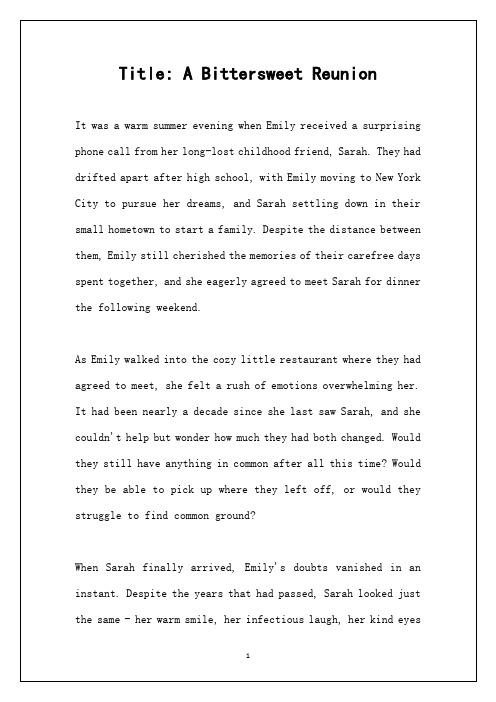
Title: A Bittersweet Reunion
It was a warm summer evening when Emily er long-lost childhood friend, Sarah. They had drifted apart after high school, with Emily moving to New York City to pursue her dreams, and Sarah settling down in their small hometown to start a family. Despite the distance between them, Emily still cherished the memories of their carefree days spent together, and she eagerly agreed to meet Sarah for dinner the following weekend.
小说英语翻译
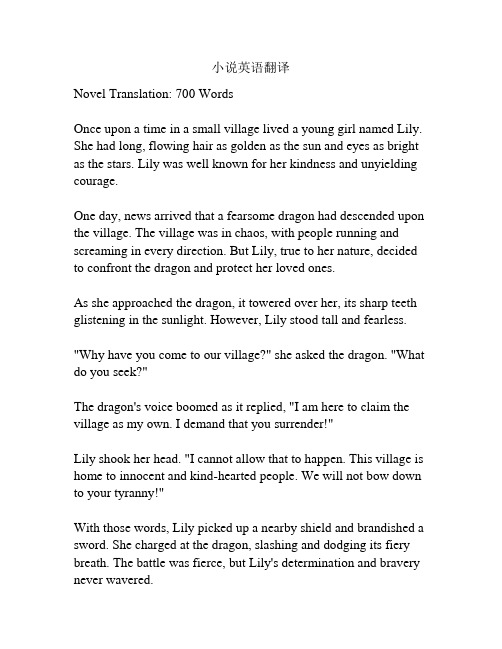
小说英语翻译Novel Translation: 700 WordsOnce upon a time in a small village lived a young girl named Lily. She had long, flowing hair as golden as the sun and eyes as bright as the stars. Lily was well known for her kindness and unyielding courage.One day, news arrived that a fearsome dragon had descended upon the village. The village was in chaos, with people running and screaming in every direction. But Lily, true to her nature, decided to confront the dragon and protect her loved ones.As she approached the dragon, it towered over her, its sharp teeth glistening in the sunlight. However, Lily stood tall and fearless."Why have you come to our village?" she asked the dragon. "What do you seek?"The dragon's voice boomed as it replied, "I am here to claim the village as my own. I demand that you surrender!"Lily shook her head. "I cannot allow that to happen. This village is home to innocent and kind-hearted people. We will not bow down to your tyranny!"With those words, Lily picked up a nearby shield and brandished a sword. She charged at the dragon, slashing and dodging its fiery breath. The battle was fierce, but Lily's determination and bravery never wavered.After what felt like hours, Lily managed to wound the dragon. Seizing the opportunity, she lunged forward and delivered the final blow. The dragon let out a mighty roar before falling to the ground.The village erupted in cheers as Lily stood triumphantly over the defeated dragon. The villagers gathered around her, expressing their gratitude for her bravery and heroism.From that day forward, Lily became a symbol of hope and courage. She reminded the villagers to never back down in the face of adversity and to always stand up for what is right.Years passed, and Lily grew older and wiser. She continued to protect her village from any threats that came their way. Her fame spread far and wide, and people from across the land sought her counsel and guidance.Lily's story became legendary, passed down from generation to generation. She became a folk hero, an embodiment of bravery and selflessness.But no matter how famous she became, Lily remained humble. She never sought glory or recognition, only the well-being of her village and its people.And so, the story of Lily, the young girl who defeated the fearsome dragon, serves as a reminder that heroes come in all shapes and sizes. It is not strength alone that defines a hero, but also their unwavering spirit and courage in the face of adversity.。
外文原著小说带翻译

外文原著小说带翻译Title: The Catcher in the Rye A Study of Holden Caulfield's Mental State。
Introduction。
The Catcher in the Rye is a novel written by J.D. Salinger in 1951. It is a story about a teenage boy named Holden Caulfield who has been expelled from his school and is wandering around New York City. The novel is written in first-person narrative, and it is a study of Holden's mental state.Holden Caulfield's Mental State。
Holden Caulfield is a complex character, and his mental state is the central theme of the novel. Holden is a troubled teenager who is struggling to cope with the loss of his brother Allie, who died of leukemia. Holden is also struggling with the idea of growing up and entering theadult world. He is a character who is constantly searching for meaning and purpose in his life.Holden's mental state is characterized by his feelings of alienation, loneliness, and depression. He is a character who is isolated from the world around him, and he feels disconnected from the people and the society he lives in. Holden's alienation is a result of his inability to connect with people on an emotional level. He is unable to form meaningful relationships with others, and he is constantly searching for someone who can understand him.Holden's loneliness is also a result of his alienation. He is a character who is desperately seeking companionship, but he is unable to find it. Holden is a character who is constantly searching for someone who can understand him and share his experiences. He is a character who is desperately seeking human connection, but he is unable to find it.Holden's depression is a result of his alienation and loneliness. He is a character who is struggling to find meaning and purpose in his life. Holden is a character whois constantly searching for something that will make him happy, but he is unable to find it. His depression is also a result of his inability to cope with the loss of his brother Allie.Conclusion。
小说翻译
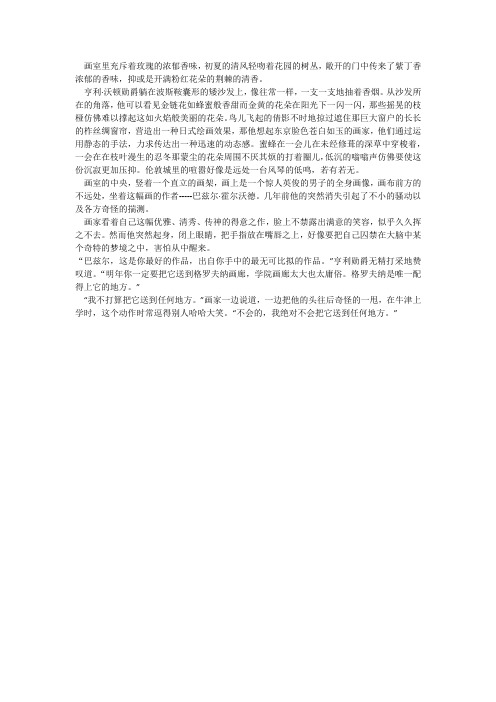
画室里充斥着玫瑰的浓郁香味,初夏的清风轻吻着花园的树丛,敞开的门中传来了紫丁香浓郁的香味,抑或是开满粉红花朵的荆棘的清香。
亨利·沃顿勋爵躺在波斯鞍囊形的矮沙发上,像往常一样,一支一支地抽着香烟。
从沙发所在的角落,他可以看见金链花如蜂蜜般香甜而金黄的花朵在阳光下一闪一闪,那些摇晃的枝桠仿佛难以撑起这如火焰般美丽的花朵。
鸟儿飞起的倩影不时地掠过遮住那巨大窗户的长长的柞丝绸窗帘,营造出一种日式绘画效果,那他想起东京脸色苍白如玉的画家,他们通过运用静态的手法,力求传达出一种迅速的动态感。
蜜蜂在一会儿在未经修葺的深草中穿梭着,一会在在枝叶漫生的忍冬那蒙尘的花朵周围不厌其烦的打着圈儿,低沉的嗡嗡声仿佛要使这份沉寂更加压抑。
伦敦城里的喧嚣好像是远处一台风琴的低鸣,若有若无。
画室的中央,竖着一个直立的画架,画上是一个惊人英俊的男子的全身画像,画布前方的不远处,坐着这幅画的作者-----巴兹尔·霍尔沃德。
几年前他的突然消失引起了不小的骚动以及各方奇怪的揣测。
画家看着自己这幅优雅、清秀、传神的得意之作,脸上不禁露出满意的笑容,似乎久久挥之不去。
然而他突然起身,闭上眼睛,把手指放在嘴唇之上,好像要把自己囚禁在大脑中某个奇特的梦境之中,害怕从中醒来。
“巴兹尔,这是你最好的作品,出自你手中的最无可比拟的作品。
”亨利勋爵无精打采地赞叹道。
“明年你一定要把它送到格罗夫纳画廊,学院画廊太大也太庸俗。
格罗夫纳是唯一配得上它的地方。
”“我不打算把它送到任何地方。
”画家一边说道,一边把他的头往后奇怪的一甩,在牛津上学时,这个动作时常逗得别人哈哈大笑。
“不会的,我绝对不会把它送到任何地方。
”。
外国英语小说带翻译

外国英语小说带翻译The Great Gatsby 《了不起的盖茨比》。
The Great Gatsby is a novel written by F. Scott Fitzgerald, which was first published in 1925. The story is set in the summer of 1922 and revolves around the lives of Jay Gatsby, a wealthy young man, and his love for Daisy Buchanan, a married woman.The novel is narrated by Nick Carraway, a young man from the Midwest who moves to New York to work in the bond business. He becomes neighbors with Gatsby, who throws extravagant parties in the hope that Daisy will attend. Nick becomes friends with Gatsby and learns about his past and his obsession with Daisy.The novel explores themes of love, wealth, and the American Dream. Gatsby's pursuit of wealth and status is fueled by his desire to win Daisy's love, but ultimately leads to his downfall. The characters in the novel are allflawed, with their own desires and motivations.Fitzgerald's writing is known for its lyrical prose andvivid descriptions of the Jazz Age.The Great Gatsby has been adapted into several films, including the 2013 Baz Luhrmann version starring Leonardo DiCaprio as Gatsby and Carey Mulligan as Daisy. The novel continues to be a popular choice for literature classes and book clubs, and is considered a classic of American literature.《了不起的盖茨比》是F. Scott Fitzgerald所写的小说,首次出版于1925年。
小说翻译

Examples from A Dream of Red Mansions by Cao Xueqin
鸳鸯指着他骂到:“什么‘好话’! 宋微宗 的鹰,赵子昂的马,都是好画儿,什么‘喜 事’! 状元痘儿灌的浆儿又满是喜事。” (allusion and slang) Pointing an accusing finger at her she swore, "What's all this talk of 'good news ' and 'good fortune? '”
About Fiction
Categorization: :
1. 按 篇 幅 —— 微 型 小 说 ( mini-novel ) , 短 篇 小 说 ( novelette ) , 中 篇 小 说 ( novella ) , 长 篇 小 说 (novel) 2.按题材——武侠小说,推理小说,历史小说,言情小 说,科幻小说,奇幻小说,玄幻小说,探险小说,恐怖 小说,冶艳小说, 讽刺小说,神怪小说, 电影小说, 架空历史小说, 网游小说, 轻小说, 军事小说, 色情 小说。 3.按流派——古典主义小说,现实主义小说,浪漫主义 小说,形式主义小说,表现主义小说,存在主义小说, 意识流小说,黑色幽默,新小说派,魔幻现实主义。
Domestication &Foreignization
归化和异化的概念是由美籍意大利学 者劳伦斯韦努蒂(Lawrence Venuti) 于 1995 年 在 他 的 名 著 《 译 者 的 隐 身 ——— 部 翻 译 史 》(The Translator’s Invisibility: A History of Translation)中提出的:异化以源语或 者原文作者为归宿,归化以目的语或 者译文读者为归宿。
小说翻译
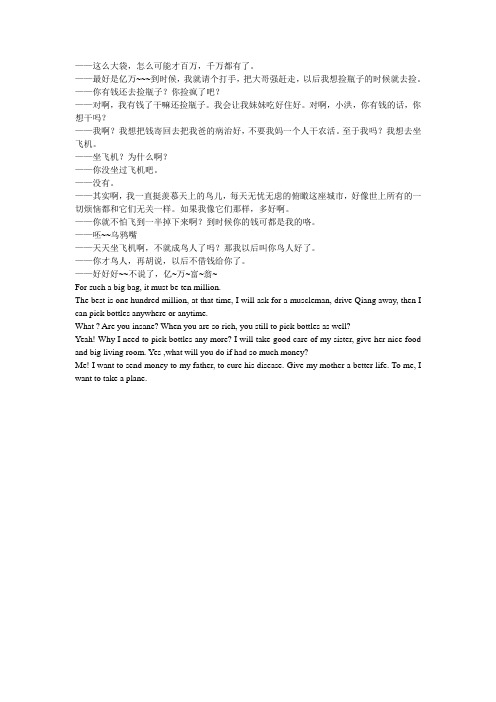
——这么大袋,怎么可能才百万,千万都有了。
——最好是亿万~~~到时候,我就请个打手,把大哥强赶走,以后我想捡瓶子的时候就去捡。
——你有钱还去捡瓶子?你捡疯了吧?——对啊,我有钱了干嘛还捡瓶子。
我会让我妹妹吃好住好。
对啊,小洪,你有钱的话,你想干吗?——我啊?我想把钱寄回去把我爸的病治好,不要我妈一个人干农活。
至于我吗?我想去坐飞机。
——坐飞机?为什么啊?——你没坐过飞机吧。
——没有。
——其实啊,我一直挺羡慕天上的鸟儿,每天无忧无虑的俯瞰这座城市,好像世上所有的一切烦恼都和它们无关一样。
如果我像它们那样,多好啊。
——你就不怕飞到一半掉下来啊?到时候你的钱可都是我的咯。
——呸~~乌鸦嘴——天天坐飞机啊,不就成鸟人了吗?那我以后叫你鸟人好了。
——你才鸟人,再胡说,以后不借钱给你了。
——好好好~~不说了,亿~万~富~翁~For such a big bag, it must be ten million.The best is one hundred million, at that time, I will ask for a muscleman, drive Qiang away, then I can pick bottles anywhere or anytime.What ? Are you insane? When you are so rich, you still to pick bottles as well?Yeah! Why I need to pick bottles any more? I will take good care of my sister, give her nice food and big living room. Yes ,what will you do if had so much money?Me! I want to send money to my father, to cure his disease. Give my mother a better life. To me, I want to take a plane.。
项链英文小说带翻译

项链英文小说带翻译The Necklace: A Story of Love and Loss。
项链,一段关于爱与失落的故事。
Once upon a time, there was a young couple deeply in love. They had been together for several years and were planning to get married soon. The young man, Jack, wanted to give his beloved fiancée, Lily, a special gift to show his love and commitment to her. He decided to buy her a beautiful necklace, one that would sparkle and shine just like her eyes.从前,有一对深爱的年轻情侣。
他们在一起已经几年了,计划很快就要结婚。
年轻的男人杰克想要给他心爱的未婚妻莉莉一份特别的礼物,以表达他对她的爱和承诺。
他决定给她买一条漂亮的项链,一条会像她的眼睛一样闪耀和发光的项链。
Jack spent weeks searching for the perfect necklace. He went to every jewelry store in town, but nothing seemed tomeet his standards. Finally, he stumbled upon a small boutique that had a necklace that caught his eye. It was made of delicate gold chains and had a single diamond pendant in the center. Jack knew that this was the one.杰克花了几个星期的时间寻找完美的项链。
小说-early-autumn-翻译
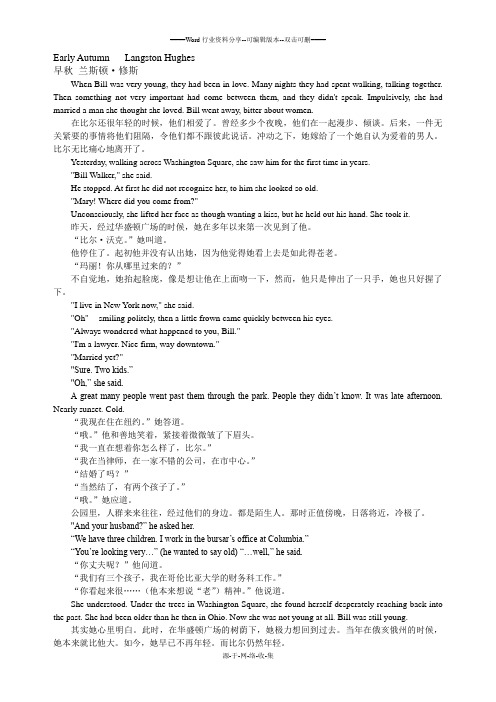
Early Autumn Langston Hughes早秋兰斯顿·修斯When Bill was very young, they had been in love. Many nights they had spent walking, talking together. Then something not very important had come between them, and they didn't speak. Impulsively, she had married a man she thought she loved. Bill went away, bitter about women.在比尔还很年轻的时候,他们相爱了。
曾经多少个夜晚,他们在一起漫步、倾谈。
后来,一件无关紧要的事情将他们阻隔,令他们都不跟彼此说话。
冲动之下,她嫁给了一个她自认为爱着的男人。
比尔无比痛心地离开了。
Yesterday, walking across Washington Square, she saw him for the first time in years."Bill Walker," she said.He stopped. At first he did not recognize her, to him she looked so old."Mary! Where did you come from?"Unconsciously, she lifted her face as though wanting a kiss, but he held out his hand. She took it.昨天,经过华盛顿广场的时候,她在多年以来第一次见到了他。
“比尔·沃克。
”她叫道。
他停住了。
起初他并没有认出她,因为他觉得她看上去是如此得苍老。
英语小说带翻译故事

英语小说带翻译故事Title: A Heartwarming Story。
Once upon a time, there was a small town nestled in the mountains. The town was filled with kind-hearted people who always helped each other out in times of need. Among them was a young girl named Lily, who was known for her cheerful personality and her love for animals.One day, while walking through the woods, Lily stumbled upon a small, injured bird. Without hesitation, she scooped up the bird and took it back to her home. She carefully tended to the bird's wounds and nursed it back to health.As the days went by, Lily grew attached to the bird and named it Hope. She would spend hours playing with Hope and teaching it how to fly. Eventually, Hope was strong enough to fly on its own, but it didn't leave Lily's side. It would follow her wherever she went, perching on her shoulder or sitting on her lap.One day, while out for a walk, Lily and Hope came across an old woman who was struggling to carry a heavy load of firewood. Without hesitation, Lily offered to help the woman. Together, they carried the firewood back to the woman's home.The woman was so grateful for Lily's help that she invited her and Hope inside for a cup of tea. As they sat and chatted, the woman told Lily about her lonely life and how much she missed having someone to talk to. Lily listened intently and promised to visit the woman again soon.From that day on, Lily and Hope would visit the woman regularly, bringing her food and keeping her company. The woman's once lonely life was now filled with laughter and joy, thanks to Lily and Hope.As the years went by, Lily grew up and moved away from the small town. But she never forgot about the woman and Hope. She would often write letters and send pictures ofHope, who had grown into a beautiful bird.One day, Lily received a letter from the woman's son, informing her that the woman had passed away. Lily was heartbroken, but she knew that Hope had brought joy to the woman's life and had made her last years happier.Lily returned to the small town to attend the woman's funeral. As she stood by the woman's grave, she felt a small breeze brush past her face. She looked up to see Hope perched on a nearby tree, watching over her.In that moment, Lily knew that Hope had not only brought joy to the woman's life, but had also brought comfort to her in her final moments. Lily smiled and whispered a thank you to the bird before walking away, feeling grateful for the heartwarming story that had unfolded in her life.。
幽默英语小说带翻译
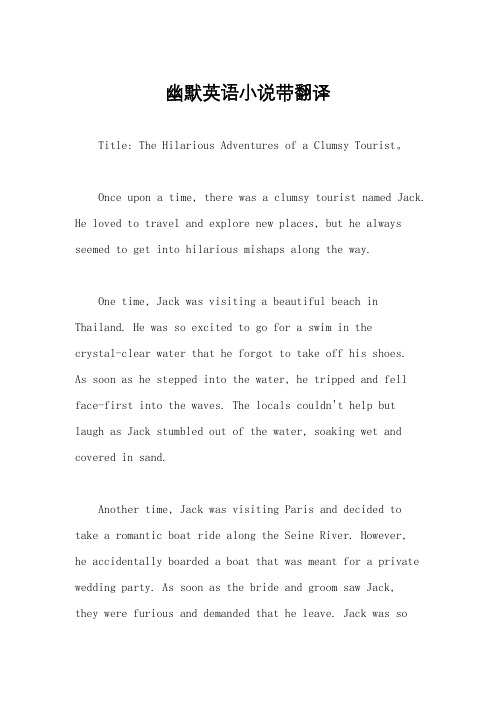
幽默英语小说带翻译Title: The Hilarious Adventures of a Clumsy Tourist。
Once upon a time, there was a clumsy tourist named Jack. He loved to travel and explore new places, but he always seemed to get into hilarious mishaps along the way.One time, Jack was visiting a beautiful beach in Thailand. He was so excited to go for a swim in thecrystal-clear water that he forgot to take off his shoes.As soon as he stepped into the water, he tripped and fell face-first into the waves. The locals couldn't help but laugh as Jack stumbled out of the water, soaking wet and covered in sand.Another time, Jack was visiting Paris and decided to take a romantic boat ride along the Seine River. However,he accidentally boarded a boat that was meant for a private wedding party. As soon as the bride and groom saw Jack,they were furious and demanded that he leave. Jack was soembarrassed that he quickly jumped off the boat and swam to shore.Despite all of his mishaps, Jack never lost his sense of humor. He always found a way to laugh at himself and make others laugh along with him. In fact, he even started a blog where he shared his hilarious travel stories with the world.One of Jack's most popular blog posts was about histrip to Japan. He had heard that it was customary to bow when greeting someone, so he practiced his bowing skills before he arrived. However, when he finally met a Japanese local, he accidentally bowed so low that he fell over and knocked over a display of souvenirs. The local was shocked, but Jack quickly apologized and offered to pay for the damages. The two ended up laughing about the incident and even became friends.Jack's hilarious adventures continued as he traveled the world. He once got lost in a maze in England and had to be rescued by a group of schoolchildren. He alsoaccidentally ordered a plate of snails in France, thinking they were escargot, and ended up spitting them out in disgust.Despite all of his mishaps, Jack never let his clumsiness hold him back from exploring the world. He continued to travel and make new friends, always with a smile on his face and a funny story to tell.In the end, Jack's blog became so popular that he was able to turn his hilarious travel stories into a book. It became a bestseller and inspired others to embrace their own quirks and laugh at themselves along the way. Jack's clumsy adventures may have caused him some embarrassment, but they also brought him joy, laughter, and unforgettable memories.。
小说翻译的发展现状

小说翻译的发展现状近年来,小说翻译行业正迅速发展,并取得了长足的进步。
随着全球化的不断推进,人们对于不同文化之间的交流与了解的需求越来越迫切,这也为小说翻译行业带来了更大的发展空间。
小说翻译的发展现状表现在多个方面。
首先,传统的小说翻译领域在不断扩大,涉及的语种与风格也更加丰富。
以前,各国读者更多地只关注自己国家的文学作品,而现在,随着翻译技术的不断革新和市场的开放,人们可以更轻松地接触到来自世界各地的优秀小说作品。
其次,在小说翻译领域,专业水准的不断提高也是一大亮点。
翻译人员需要具备出色的语言能力和文学素养,以克服语言和文化差异所带来的挑战。
他们要将原作的情感、语言风格以及文化内涵完美地呈现在目标语言读者面前,这需要他们有更高的翻译技巧和艺术修养。
此外,小说翻译的发展还受益于技术的支持。
随着机器翻译和辅助翻译工具的不断进步,翻译人员可以更快速、准确地完成翻译任务。
这些技术的应用使得翻译工作更加高效,也为小说翻译的质量提供了更可靠的保障。
然而,小说翻译行业仍然面临一些挑战。
首先,由于语言和文化的差异,一些作品在翻译过程中可能会失去原作的独特魅力。
翻译人员需要在保留原作意义的基础上,尽可能地传递原作的美感和文化内涵。
另外,市场需求的不断变化也对小说翻译行业提出了新的要求。
读者对于作品的审美趣味不断改变,他们对多元化的文学作品有着更高的期待。
因此,翻译人员需要紧跟时代潮流,选择有代表性的作品,并灵活运用翻译技巧,以满足读者对多元化阅读体验的需求。
总之,小说翻译行业正处于快速发展的阶段,并具有巨大的潜力。
随着全球交流的日益加深,小说翻译将继续扮演着促进不同文化之间相互理解和交流的重要角色。
翻译人员需要以专业素养和翻译技巧为基础,不断提升自己的能力,为读者呈现更多优秀的小说作品。
英文小说中文翻译版-威廉·莎士比亚全集

“艾菲!你到底在干什么?”她丈夫的声音刺破了她狂喜的心情,使她的心脏像猫一样跳动,但由于女性自我控制的奇迹,她的身体没有出现震颤。
亲爱的上帝,她想,他一定不要看到它。
它是如此美丽,他总是杀死美丽。
她无精打采地说:“我只是看着月亮。
它是绿色的。
”一定不要,一定不要看到它。
而现在,幸运的是,他不会。
因为好像脸也听到并感觉到了声音中的威胁,他的脸正从窗户的光芒移回黑暗中,但是那是缓慢的,勉强的,仍然像妖精一样。
,恳求,哄骗,诱人和令人难以置信的美丽。
“马上关上百叶窗,你这个小傻瓜,然后离开窗户!”她梦dream以求地说道:“绿色如啤酒瓶,绿色如翡翠,绿色如树叶,阳光照耀着它们,绿草如茵。
”她忍不住说了那些最后的话。
即使听不见,它们也是她的表情。
“艾菲!”她知道最后一声是什么意思。
她疲倦地转过身,关闭了繁琐的铅制内百叶窗,将沉重的螺栓赶回家。
那伤了她的手指;它总是如此,但他一定不知道这一点。
“你知道不要碰那些百叶窗!至少还要五年!”她说:``我只想看月亮,转过身来,然后一切都消失了-脸上,夜晚,月亮,魔法......而她又回到了肮脏,陈旧的小洞里,面对一个生气,陈旧的小男人。
那时,空调风扇的永恒响声和过滤掉灰尘的静电除尘器的crack啪声再次像牙医的咬牙一样达到了她的意识。
“只想看看月亮!”他用假话模仿了她。
“只想像个傻瓜一样死去,让我更加为你感到羞耻!”然后他的声音变得嘶哑而专业。
“在这里,算你自己。
”她默默地拿起他与手臂保持距离的Geiger计数器,等到它稳定下来直到比时钟慢一点的滴答声时-由于宇宙射线并且没有任何危险,然后才开始用仪器梳理自己的身体。
首先,她的头和肩膀,然后是手臂,然后是身体的下侧,尽管她的特征是灰色和下垂的,但她的动作还是有些奇怪。
直到她来到腰间时,滴答声才改变了节奏。
然后突然爆发,点击越来越快。
丈夫激动地咕gr一声,向前迈了一步,僵住了。
她恐惧中凝视了一下,然后愚蠢地笑了起来,挖进了她肮脏的围裙的口袋,内地掏出了一只手表。
第七章——小说翻译
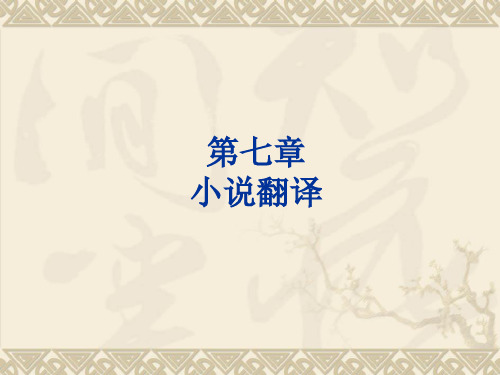
1.什么是小说翻译? 什么是小说翻译? 什么是小说翻译
1.1小说的定义:《现代汉语词典》(第5版)的解 小说的定义: 现代汉语词典》 小说的定义 版 释是: 一种叙事性的文学体裁, 释是:“一种叙事性的文学体裁,通过人物的所造 和情节、环境的描述来概括地表现社会生活的矛盾。 和情节、环境的描述来概括地表现社会生活的矛盾。
(/view/4721ce323968011ca3009114.html) )
1.2 小说的分类: 小说的分类: 按篇幅——微型小说(mini-novel),短篇小说 微型小说( ),短篇小说 按篇幅 微型小说 ), ),长篇小说 (novelette) ,中篇小说(novella),长篇小说 ) 中篇小说( ), (novel)。 )。 按题材——武侠小说,推理小说,历史小说,言情 武侠小说, 按题材 武侠小说 推理小说,历史小说, 小说,科幻小说,探险小说,恐怖小说, 讽刺小说, 小说,科幻小说,探险小说,恐怖小说, 讽刺小说, 神怪小说, 电影小说等。 神怪小说, 电影小说等。 按流派——古典主义小说,现实主义小说,浪漫主 按流派 古典主义小说,现实主义小说, 古典主义小说 义小说,形式主义小说,表现主义小说, 义小说,形式主义小说,表现主义小说,存在主义 小说,意识流小说,黑色幽默,新小说派, 小说,意识流小说,黑色幽默,新小说派,魔幻现 实主义等。 实主义等。(/view/4721ce323968011ca3009114.html)
① ②
北京: (何其莘,仲伟合,许钧总主编;胡显耀,李力主编.《高级文学翻译》—北京:外语 何其莘,仲伟合,许钧总主编;胡显耀,李力主编 《高级文学翻译》 北京 教学与研究出版社, 教学与研究出版社,2009.6,第204页) , 页
英文小说翻译
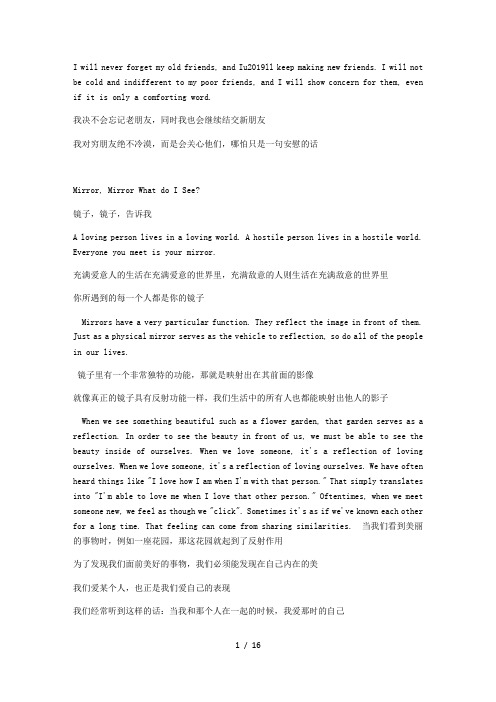
I will never forget my old friends, and Iu2019ll keep making new friends. I will not be cold and indifferent to my poor friends, and I will show concern for them, even if it is only a comforting word.我决不会忘记老朋友,同时我也会继续结交新朋友我对穷朋友绝不冷漠,而是会关心他们,哪怕只是一句安慰的话Mirror, Mirror What do I See?镜子,镜子,告诉我A loving person lives in a loving world. A hostile person lives in a hostile world. Everyone you meet is your mirror.充满爱意人的生活在充满爱意的世界里,充满敌意的人则生活在充满敌意的世界里你所遇到的每一个人都是你的镜子Mirrors have a very particular function. They reflect the image in front of them. Just as a physical mirror serves as the vehicle to reflection, so do all of the people in our lives.镜子里有一个非常独特的功能,那就是映射出在其前面的影像就像真正的镜子具有反射功能一样,我们生活中的所有人也都能映射出他人的影子When we see something beautiful such as a flower garden, that garden serves as a reflection. In order to see the beauty in front of us, we must be able to see the beauty inside of ourselves. When we love someone, it's a reflection of loving ourselves. When we love someone, it's a reflection of loving ourselves. We have often heard things like "I love how I am when I'm with that person." That simply translates into "I'm able to love me when I love that other person." Oftentimes, when we meet someone new, we feel as though we "click". Sometimes it's as if we've known each other for a long time. That feeling can come from sharing similarities. 当我们看到美丽的事物时,例如一座花园,那这花园就起到了反射作用为了发现我们面前美好的事物,我们必须能发现在自己内在的美我们爱某个人,也正是我们爱自己的表现我们经常听到这样的话:当我和那个人在一起的时候,我爱那时的自己这句话也可以简单地说成:在我爱那个人的同时,我也能爱我自己有时,我们遇见一个陌生人,感觉仿佛是一见如故,就好像我们已经相识甚久这种熟悉感可能来自于彼此身上的共同点Just as the "mirror" or other person can be a positive reflection, it is more likely that we'll notice it when it has a negative connotation. For example, it's easy to remember times when we have met someone we're not particularly crazy about. We may have some criticism in our mind about the person. This is especially true when we get to know someone with whom we would rather spend less time.就像镜子或他人能映射出我们积极的一面一样,我们更有可能注意到映射出自己消极方面的镜子例如,我们很容易就能记住我们碰到自己不太喜欢的人的时刻我们可能在心里对那个人有些反感当我们认识自己不喜欢与之相处的人时,这种情况就更为明显Frequently, when we dislike qualities in other people, ironically, it's usually the mirror that's speaking to us.具有讽刺意味着的是,通常当我们讨厌别人身上的某些特质时,那就说明你其实讨厌自己身上相类似的特质I began questioning myself further each time I encountered someone that I didn't particularly like. Each time, I asked myself, "What is it about that person that I don't like?" and then "Is there something similar in me?" in every instance, I could see a piece of that quality in me, and sometimes I had to really get very introspective. So what did that mean?每次,当我遇到不太喜欢的人时,我就开始进一步质问自己我会扪心自问:我不喜欢那个人的哪些方面?然后还会问:我是不是有和他相似的地方?每次,我都能在自己身上看到一些令我厌恶的特质我有时不得不深刻地反省自己那这意味着什么呢?It means that just as I can get annoyed or disturbed when I notice that aspect in someone else, I better reexamine my qualities and consider making some changes. Even if I'm not willing to make a drastic change, at least I consider how I might modifysome of the things that I'm doing.这意味着,就像我会对其他人身上令我厌恶的特质感到恼怒或不安一样,我应该更好地重新审视自己的特质,并考虑做一些改变即使我不想做大的改变,至少我会考虑该如何修正自己正在做的一些事情At times we meet someone new and feel distant, disconnected, or disgusted. Although we don't want to believe it, and it's not easy or desirable to look further, it can be a great learning lesson to figure out what part of the person is being reflected in you. It's simply just another way to create more self-awareness.我们时常会遇到陌生人,并感到疏远或厌恶尽管我们不想去相信,不容易也不想去深究,但是弄清楚别人的哪些特质在自己身上有所体现是非常有意义的一课,这也正是增强自我意识的另一个途径股神巴菲特在美国东部时间17日确诊患前列腺癌,以下为巴菲特致伯克希尔-哈撒韦股东的信This is to let you know that I have been diagnosed with stage I prostate cancer. The good news is that Iu2019ve been told by my doctors that my condition is not remotely life-threatening or even debilitating in any meaningful way. I received my diagnosis last Wednesday. I then had a CAT scan and a bone scan on Thursday, followed by an MRI today. These tests showed no incidence of cancer elsewhere in my body.在此告知各位我已被诊断患一期前列腺癌症好消息是医生告知我的病情远不危及生命,甚至不会显著影响身体机能上周三我接受了诊断,周四做了CAT扫描和骨扫描,今天(周三)做了核磁共振这些检查均未显示身体其余部分患癌My doctors and I have decided on a two-month treatment of daily radiation to begin in mid-July. This regimen will restrict my travel during that period, but will not otherwise change my daily routine.医生和我本人决定,从7月中旬开始进行为期两个月的每日放疗在此期间我的出行将受到限制,但日常工作不会发生变化I feel great as if I were in my normal excellent health and my energy level is 100 percent. I discovered the cancer because my PSA level (an indicator my doctors had regularly checked for many years) recently jumped beyond its normal elevationand a biopsy seemed warranted.我感觉良好仿佛处于正常的良好健康状态中我的精力十分充沛我发现自己患癌,是因为前列腺特异性抗原(PSA,多年来我的大夫做例行检查的一项指标)水平近来远超正常水平,活检似乎得到确认I will let shareholders know immediately should my health situation change. Eventually, of course, it will; but I believe that day is a long way off.如果病情发生变化,我将立刻通知各位股东当然,那一天终将到来,但我相信离那一天还挺远Everyone wants to succeed. But what would you do if you failed? Many people may choose to give up. However, the surest way to success is to keep your direction and stick to your goal.每个人都想成功但是如果失败了你会怎么做?很多人可能会选择放弃然而,要想成功,最可靠的方法就是坚持你的方向和目标On your way to success, you must keep your direction. Direction is just like a lamp, guiding you in darkness and helping you overcome obstacles on your way. Otherwise, you will easily get lost or hesitate to go ahead.在通往成功的路上,你必须坚持你的方向它就像一盏明灯,在黑暗中为你指路,帮助你度过难关否则,你很容易就会迷失方向或犹豫不前Direction means objectives. You can get nowhere without an objective in life. 方向意味着目标人生没有目标,将会一事无成You can try to write your objective on paper and make some plans to achieve it. In this way, you will know how to arrange your time and how to spend your time properly. And you should also have a belief that you are sure to succeed as long as you keep your direction all the time.你可以试着把你的目标写在纸上,并制订实现目标的计划这样,你就会懂得如何合理安排时间,如何正确支配时间而且你还要有这样的信念:只要你一直坚持自己的方向,你就一定可以成功1. It hurts to love someone and not be loved in return, but what is more painful is to love someone and never find the courage to let that person know you feel. 1. 爱一个人却得不到爱的回报是令人伤心的更痛苦的是,爱上一个人却没有勇气让这个人知道你的感受2. Maybe God wants us to meet a few wrong people before meeting the right one so that when we finally meet the right person, we will know how to be grateful for that gift.2. 也许上帝希望我们在邂逅合适的人之前先遇到一些不合适的人,这样当我们遇到合适的人时,我们就知道对这份礼物心怀感激了3. Love is when you take away the feeling, the passion, and the romance in a relationship and find out you still care for that person.3. 爱是当你抽离了感情、激情和浪漫后,却发觉你依然关注着那个人4. A sad thing in life is when you meet someone who means a lot to you, only to find out in the end that it was never meant to be and you just have to let go. 4. 生命中的悲哀莫过于遇到了一个对你来说很重要的人,却最终发现错于无缘,终究不得不放弃5. When the door of happiness closes, another opens, but often times we look so long at the closed door that we don't see the one which has been opened for us. 5. 当幸福的一扇门关闭时,另一扇门便会敞开,但是因为我们通常都凝视着那扇紧闭的门太久了,却没注意到另一扇门已经为我们敞开6. The best kind of friend is the kind you can sit on a porch , never say a word, and then walk away feeling like it was the best conversion you've ever had.6. 最好的朋友即使只是同你一起坐在门廊前默默地打秋千,然后离开,也会让你感受到那是你有过的最好的交谈7. It's true that we don't know what we've got until we lose it, but it's also true that we don't know what we've been missing until it arrives.7. 事实上直到失去的时候,我们才知道自己曾拥有过什么,但另一个事实是,只有等到出现时,我们才知道自己所盼望的是什么8. Giving someone all your love is never an assurance that they'll love you back! Don't expect love in return, just wait for it to grow in their heart but , be content it grew in yours.8. 将你全部的爱都给予一个人,并不能保证别人会回报以爱!不要期待着爱的回报,仅仅等待爱在心中成长.9. There are things you'd love to hear that you would never hear from the person whom you would like to hear them from, but don't be so deaf as not to hear it from the one who says it from his heart.9. 也许你喜欢的人没有从口中说出那些你爱听的话,但是对他的肺腑之言你却不要充耳不闻10. Never say good-eye if you still want to try. Never give up if you still feel you can go on. Never say you don't love a person any more if you can't let go. 10. 如果还想努力,你就别说再见如果仍想继续,你就别轻易放弃如果不能放弃,你就别说再也不爱他11. Love comes to those who still hope although they've been disappointed; to those who still believe, although they've been betrayed; to those who still need to love, although they've been hurt before; and to those who have the courage and faith to build trust again.11. 爱青睐那些虽然曾经失望但仍然满怀希望的人;青睐那些虽然被背叛但依然充满信心的人;青睐那些虽然曾经受过伤害但仍旧需要关爱的人;青睐那些有勇气和信念重塑信任的人12. It takes only a minute to get a crush on someone, an hour to like someone, anda day to love someone but it takes a lifetime to forget someone.12. 迷上一个人只需一分钟,喜欢上一个人需要一小时,爱上一个人需要一天,但是忘记一个人却需要一辈子13. Don't go for looks; they can deceive. Don't go for wealth; even that fades away. Go for someone who makes you smile because it takes only a smile to make a dark day seem bright.13. 不要追求外表,它们具有欺骗性;不要追求财富,它最终也会消亡寻找使你欢笑的那个人吧!因为仅仅一个微笑就会使黑暗变得光明14. Dream what you want-to dream; go where you want to go; be what you want to be, because you have only one life and one chance to do all the things you want to do.14. 梦着你的梦想,去你想去的地方,做你想做的人吧!因为你只有一生和一个机会去做所有你想做的是事情15. May you have enough happiness to make you sweet, enough trials to make you strong, enough sorrow to keep you human, and enough hope to make you happy.15. 你可能已经拥有了足够多的幸福让你感到甜蜜,有足够多的磨难让你变得更坚强,有足够多的悲哀让你更富有同情心,有足够多的希望让你更享快乐16. The beginnings of love is to let those we love be just themselves, and not twist them with our own image-otherwise, we love only the reflection of ourselves we find in them.16. 爱之初,让我们所爱的人保持他们的本色,不要把他们强扭成我们设想的模样,否则我们所爱的仅仅是我们在他们身上的影子My dear daughter: You are a wonderful person and your mother and I think the world of you. It will not be long before you leave home to make your way in the world. Can I please give you some friendly advice? Here are some things that you should never do.你是了不起的人,我和妈妈非常爱你你离开家走上社会的日子不远了我可以给你一些善意的建议吗?这是几个你绝不能做的事情1. Never Get Obsessed with your Appearance.1. 绝不要为自己的外貌而烦恼We think you look great (though some of the outfits you wear worry us!). Please be happy with the person you are and the body you have. Eat sensibly, take exercise and be healthy. You look fine.我们认为你长得很美(尽管你穿的某些时装令我们担忧!)你就是你,不要为自己的外貌烦恼要合理膳食,多做运动,保持健康有些女孩子为减肥或塑造完美的身材而烦恼但你已经很好了2. Never Get Involved with a Married Man.2. 绝不要和已婚男人纠缠不清There are plenty of great single men out there. Don't get entangled with a married man no matter how attractive he isit will end in your tears.外面有许多优秀的单身男人不要和已婚男人搅在一起,不管他多么有魅力不然你就等着以泪洗面吧3. Never Compromise Your Personal Safety.3. 绝不要危及个人安全Never put yourself at serious risk. This means that you cannot trust people until you really know them and that sometimes you have to avoid things that look like they might be fun. Never get drunk or take drugs. Unfortunately there are some malevolent people out there and it is best not to take undue risks.绝不要让自己处于危险的境地就是说,不要相信还不真正了解的人,有时还要回避看似有趣的活动绝不要酗酒或吸毒不幸的是,这个社会总还是有不好的人,所以最好不要过度冒险4. Never Live Beyond Your Means.4. 生活费用绝不要超支Throughout life try to keep your spending within your income and so save a little. Avoid getting into debt if possible. There are some exceptionslike getting a mortgage to buy a housebut generally if you can live within your means you will avoid all sorts of problems.生活上要努力保持收支平衡,所以应该存点钱在可能的情况下避免负债当然可以有些例外如抵押贷款买房子但是总的来说,如果你能保持收支平衡就能避免各种麻烦5. Never Despise Yourself.5. 绝不要看不起自己You are great and capable of achieving great things so believe in yourself. When things go badly, never stop believing. Some girls get depressed, blame themselves and lose self-esteem. All sorts of problems can follow.你很优秀,也有能力获得美好的前程,因此要相信自己身处逆境的时候也绝不放弃有些女孩子会因此消沉下去,怪罪自己,从而失去自尊那样一来,各种问题都会随之而来6. Never Give Less Than Your Best. 永远尽力而为We are very proud of what you have accomplished so far. You should be proud too. Keep doing well. Keep trying your hardest at everything you do. No one can ask for more than that.6. 我们为你已取得的成就感到骄傲,你也应该感到自豪继续好好干继续在任何事上都尽最大努力没人能要求更多了7. Never Forget that Your Parents Love You.绝不要忘记你的父母爱你7. Whatever happens in life, your family will still be your family. Whatever difficulties you encounter you can always talk to us and we will try to help. We are here for you.生活中无论发生了什么,家始终是你的家无论你遇到什么困难,你都可以告诉家人,家人会尽力帮助你,他们是你永远的坚强后盾A man and his girlfriend were married. It was a large celebration.一个男人和他的女朋友结婚,举行了一场盛大的结婚庆典All of their friends and family came to see the lovely ceremony and to partake ofthe festivities and celebrations. All had a wonderful time.所有的朋友和家人都来到结婚典礼上参加欢宴和庆祝活动大家都过得很开心The bride was gorgeous in her white wedding gown and the groom was very dashing in his black tuxedo. Everyone could tell that the love they had for each other was true.穿着白色婚纱的新娘漂亮迷人,穿着黑色礼服的新郎英俊潇洒每个人都能看出他们彼此的爱是真诚的A few months later, the wife came to the husband with a proposal, "I read in a magazine, a while ago, about how we can strengthen our marriage," she offered. "Each of us will write a list of the things that we find a bit annoying with the other person. Then, we can talk about how we can fix them together and make our lives happier together."几个月后,妻子走近丈夫提议说:我刚才在杂志上看到一篇文章,说的是怎样巩固婚姻她说:我们两个人都各自把对方的小毛病列在一张纸上,然后我们商量一下怎样解决,以便使我们的生活更幸福The husband agreed. So each of them went to a separate room in the house and thought of the things that annoyed them about the other. They thought about this question for the rest of the day and wrote down what they came up with.丈夫同意了于是他们各自走向不同的房间去想对方的缺点那一天余下的时间里,他们都在思考这个问题,并且把他们想到的都写下来The next morning, at the breakfast table, they decided that they would go over their lists.第二天早上,吃早饭的时候,他们决定谈谈彼此的缺点"I'll start," offered the wife. She took out her list. It had many items on it, enough to fill 3 pages. In fact, as she started reading the list of the little annoyances, she noticed that tears were starting to appear in her husband's eyes.我先开始吧妻子说她拿出她的单子,上面列举了很多条,事实上,足足写满了三页当她开始念的时候,她注意到丈夫眼里含着泪花"What's wrong?" she asked. "Nothing," the husband replied, "keep reading your list."怎么啦?她问没什么,丈夫答道,继续念吧The wife continued to read until she had read all three pages to her husband. She neatly placed her list on the table and folded her hands over the top of it.妻子又接着念整整三页都念完之后她把单子整齐地放在桌上,两手交叉放在上面"Now, you read your list and then we'll talk about the things on both of our lists," she said happily.现在该你念了,然后我们谈谈所列举的缺点她高兴地说Quietly the husband stated, "I don't have anything on my list. I think that you are perfect the way that you are. I don't want you to change anything for me. You are lovely and wonderful and I wouldn't want to try and change anything about you."丈夫平静地说:我什么也没写,我觉得像你这样就很完美了,我不想让你为我改变什么你很可爱迷人,我不想让你改变The wife, touched by his honesty and the depth of his love for her and his acceptance of her, turned her head and wept.妻子被丈夫的诚实和对她深深的爱和接纳感动了,她转过头去哭起来In life, there are enough times when we are disappointed, depressed and annoyed. We don't really have to go looking for them. We have a wonderful world that is full of beauty, light and promise. Why waste time in this world looking for the bad, disappointing or annoying when we can look around us, and see the wondrous things before us?生命中我们有很多的失望、沮丧和烦恼,我们根本不需要寻找我们美妙的世界充满了美丽、光明、希望但是,当我们放眼四周时,为什么浪费时间寻找不快、失望和烦恼,而看不到我们面前的美好事物呢?If your life feels like it is lacking the power that you want and the motivation that you need, sometimes all you have to do is shift your point of view.如果你觉得心有余力不足,觉得缺乏前进的动力,有时候你只需要改变思维的角度By training your thoughts to concentrate on the bright side of things, you are more likely to have the incentive to follow through on your goals. You are less likely to be held back by negative ideas that might limit your performance.试着训练自己的思想朝好的一面看,这样你就会汲取实现目标的动力,而不会因为消极沉沦停滞不前Your life can be enhanced, and your happiness enriched, when you choose to change your perspective. Don't leave your future to chance, or wait for things to get better mysteriously on their own. You must go in the direction of your hopes and aspirations. Begin to build your confidence, and work through problems rather than avoid them. Remember that power is not necessarily control over situations, but the ability to deal with whatever comes your way.一旦变换看问题的角度,你的生活会豁然开朗,幸福快乐会接踵而来别交出掌握命运的主动权,也别指望局面会不可思议的好转你必须与内心希望与热情步调一致建立自信,敢于与困难短兵相接,而非绕道而行记住,力量不是驾驭局势的法宝,无坚不摧的能力才是最重要的Always believe that good things are possible, and remember that mistakes can be lessons that lead to discoveries. Take your fear and transform it into trust; learn to rise above anxiety and doubt. Turn your "worry hours" into "productive hours". Take the energy that you have wasted and direct it toward every worthwhile effort that you can be involved in. You will see beautiful things happen when you allow yourself to experience the joys of life. You will find happiness when you addopt positive thinking into your daily routine and make it an important part of your world.请坚信,美好的降临并非不可能,失误也许是成功的前奏将惶恐化作信任,学会超越担忧和疑虑让诚惶诚恐的时光变得富有成效不要挥霍浪费精力,将它投到有意义的事情中去当你下意识品尝生命的欢愉时,美好就会出现当你积极地看待生活,并以此作为你的日常准则时,你就会找到快乐的真谛If you can keep your head when all about you,如果所有人都失去理智,咒骂你,Are losing theirs and blaming it on you;你仍能保持头脑清醒;If you can trust yourself when all men doubt you,如果所有人都怀疑你,But make allowance for their doubting too;你仍能坚信自己,让所有的怀疑动摇;If you can wait and not be tired by waiting,如果你要等待,不要因此厌烦,Or, being lied about,don't deal in lies,为人所骗,不要因此骗人,Or, being hated, don't give way to hating,为人所恨,不要因此抱恨,And yet don't look too good, nor talk too wise;不要太乐观,不要自以为是;If you can dream and not make dreams your master;如果你是个追梦人不要被梦主宰;If you can think and not make thoughts your aim;如果你是个爱思考的人光想会达不到目标;If you can meet with triumph and disaster.如果你遇到骄傲和挫折And treat those two impostors just the same;把两者当骗子看待;If you can bear to hear the truth you've spoken如果你能忍受,你曾讲过的事实Twiseted by knaves to make a trap for fools,被恶棍扭曲,用于蒙骗傻子;Or watch the things you gave your life to broken,看着你用毕生去看护的东西被破坏,And stoop and build 'em up with wornout tools;然后俯身,用破烂的工具把它修补;If you can make one heap of all your winnings如果在你赢得无数桂冠之后And risk it on one turn of pitch-and-toss,突遇颠峰下跌之险,And lose, and start again at your beginnings失败过后,东山再起,And never breathe a word about your loss;不要抱怨你的失败;If you can force your heart and nerve and sinew如果你能迫使自己,To serve your turn long after they are gone,在别人走后,长久坚守阵地,And so hold on when there is nothin in you在你心中已空荡荡无一物Except the Will which says to them:"Hold on!";只有意志告诉你坚持!;If you can talk with crowds and keep your virtue,如果你与人交谈,能保持风度,Or walk with Kings nor lose the common touch;伴王行走,能保持距离;If neither foes nor loving friends can hurt you;如果仇敌和好友都不害你;If all men count with you, but none too much;如果所有人都指望你,却无人全心全意;If you can fill the unforgiving minute如果你花六十秒进行短程跑,With sixty second' worth of distance run 填满那不可饶恕的一分钟Yours is the Earth and everything that's in it,你就可以拥有一个世界,And which is more you'll be a Man my son!更重要的是,孩子,你是个顶天立地的人Let's face it. We all fail. 人人都有失败,不如坦然面对As we go through life we have relationships that don't work out, jobs that just aren't right, exams that we flunk, initiatives that don't succeed. The more new things we try the more failures we are likely to have. In fact, the only way to avoid failure is to do nothing new.这一生,我们总会遇到纠缠不清的人际关系、不甚满意的工作、未通过的考试,或者不曾实现的计划尝试越多,挫折也越多除非什么都不干,否则难免遭受打击The important thing is how we deal with failure. It can be part of a downward slide in which lack of confidence reinforces feelings of inadequacy and incompetence. But experiencing failure can be a learning experience and an opportunity for a fresh start.A good way to begin this process is by asking yoruself some tough questions.关键是我们如何面对失败人走下坡路,往往会自卑,感到无能为力但失败也是吸取教训、重新开始的机会要重新开始,最好认真思考下面几个问题1.What can I learn from this?我从失败中学到了什么?Take responsibility for what went wrong. OK, so it was not all your fault but some of it was. Successful people don't make excuses or blame others. They take ownership of the issues. Be critical but constructive. Try to look at the experience objectively. Make a list of the key things that happened. Analyze the list step-by-step and look for the learning points.为所犯的错承担责任的确,失败并非完全你的错,但你也确实在责难逃吧成功的人从来不为失败找借口或抱怨他人,而是坦然承担责任所以,试着客观看待挫折,列出清单,一步一步认真总结才好2. What could I have done differently? 如果重来一次会不会有不同的处理方式?What other options did you have? What choices did you make? How could you have handled it differently? With the benefit of hindsight, what different steps would you have taken?当初是否还有其他途径?可否换一种方式处理?后见之明或许能让你发现原来还有别的方法解决问题Do I need to acquire or improve some skills?我的能力是否亟待提高?Did the problem reveal some lack of skill on your part? How could you learn or improve those skills? Perhaps there are books or courses or people you could turn to. Make a self-development plan to acquire the skills and experiences you need. 挫折是否也代表你能力不足呢?该怎样弥补?或许,你可以读书、上课或向人请教制定计划,努力提高自己的能力吧4. Who can I learn from?我能向谁学习?Is there someone to whom you can turn to for advice? Did a boss, colleague or a friend see what happened? If they are constructive and supportive then ask them for some。
英语小说带翻译

英语小说带翻译Once upon a time, in a small village, there lived a farmer named John. John was an honest and hardworking man who worked tirelessly to provide for his family. He owned a small plot of land on which he grew various crops such as wheat, corn, and potatoes.One day, while John was working in his fields, he noticed something peculiar. A small, golden seed caught his eye. It was unlike anything he had ever seen before. Curious, he picked up the seed and examined it closely. It shone brightly in his hand, and he could tell that it was very valuable.Without wasting any time, John decided to plant the seed in his field. He carefully dug a hole, placed the seed inside, and covered it with soil. He watered it every day, hoping that it would grow into something magnificent.Days turned into weeks, and weeks turned into months. John diligently took care of the seed, anxiously waiting for it to sprout. Finally, after much anticipation, a small green shoot emerged from the ground. Excitedly, he watched as it grew taller and stronger each day.To his amazement, the plant that grew from the golden seed was no ordinary plant. It had golden leaves and beautiful, vibrant flowers. It towered over all the other crops, attracting the attention of everyone in the village.News of John's extraordinary plant spread like wildfire, and people from far and wide came to see it. They marveled at its beauty andasked John how he managed to grow such a remarkable plant. But John had no answers. He simply smiled and said that it was a stroke of luck.As the plant grew, it started to produce golden fruits. The fruits were unlike anything anyone had ever tasted. They were sweet and had a heavenly aroma. People were eager to get their hands on these golden fruits, believing that they possessed magical powers.John became the talk of the town, and everyone looked up to him with admiration. He couldn't believe that something so ordinary as a seed could have brought him so much success and recognition.However, John remained grounded and continued to work hard on his farm. He shared the golden fruits with his family, friends, and neighbors, spreading joy and happiness to all.The moral of the story is that sometimes, opportunities come in unexpected ways. It is up to us to seize those opportunities and make the most out of them. Just like John, who stumbled upon the golden seed, we should always keep an open mind and be ready to embrace unexpected blessings in life.。
文学翻译之小说翻译
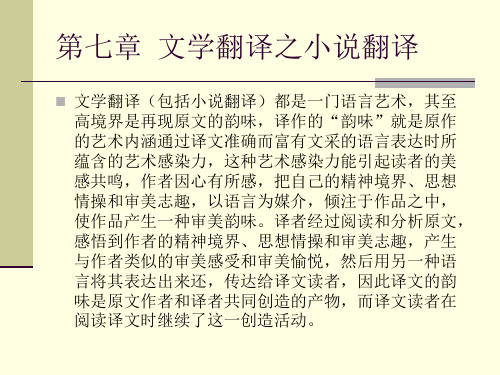
个性话的语言方式
例1:原文:北静王见他语言清朗,谈吐有致, 一面又向贾政笑道:“令郎真乃龙驹凤雏,非 小王在世翁前唐突,将来‘雏凤清于老凤声’, 未可量也。”贾政陪笑道:“犬子岂敢谬承金 奖,赖藩郡余恩,果如所言,亦萌生辈之幸 矣。”
译文:The clarity and fluency of Pao-yu’s answers made the prince turn to observe to Chia Cheng, “You son is truly a dragon’s colt or young phoenix. May I venture to predict that in time to come this young phoenix even surpass the old one?” “My worthless son does not deserve such high praise,” rejoined Chia Cheng hurriedly with a courteous smile. “If thanks to the grace of Your Highness such proves the case, that will be our good fortune.”
译文:When you are getting on in years, you tend to have a feeling that seems rather odd but, in fact, not very much so…
分析:“人到了老年”,以现在进行时译成了 “getting on in years”,不但说明“人到了老 年”是一个渐进的过程,也再现了老年人讲述 往事时悠悠的口吻。“tend to”和“feeling”依 照原文做了巧妙转换,符合说话人的心态,译 出了这两词的内涵。
小说翻译的发展现状

小说翻译的发展现状
小说翻译自古即有,但其发展现状近年来取得了巨大的进步和变化。
随着全球化的加速和互联网的普及,小说翻译行业进入了一个新的发展阶段。
首先,小说翻译的门槛大大降低。
过去,想要从事小说翻译,需要具备流利的外语水平和丰富的文学素养。
但现在,随着机器翻译的发展和普及,许多工具和软件已经能够提供准确的翻译结果。
这让许多人能够轻松地进行小说翻译,而不需要专业的翻译背景。
其次,小说翻译的市场需求不断增长。
随着人们对不同文化和文学风格的兴趣日益增加,西方小说在亚洲市场的热度也逐渐上升。
许多优秀的小说作品因为翻译而在国际上获得了更广泛的认可和读者群体。
因此,小说翻译的市场需求在各个国家都有了显著的增长。
再次,小说翻译的质量要求越来越高。
虽然机器翻译可以提供快速的翻译结果,但它无法理解文学作品的情感和文化背景。
因此,许多人更愿意雇佣专业的翻译人员来确保译作的质量。
同时,出版商和读者对小说翻译的质量也有更高的期望。
他们希望翻译能够准确地传达原作的情感和意境,使读者在阅读中能够获得与原著相似的体验。
最后,小说翻译的技术手段也在不断发展和创新。
除了传统的文字翻译,现在还出现了语音翻译和实时翻译等新技术。
这些技术的应用使得翻译工作更加高效和便捷,也提高了小说翻译
的速度和准确度。
总的来说,小说翻译行业正处于一个快速发展的阶段。
随着技术的进步和市场的需求增长,小说翻译将成为一个越来越重要的领域。
- 1、下载文档前请自行甄别文档内容的完整性,平台不提供额外的编辑、内容补充、找答案等附加服务。
- 2、"仅部分预览"的文档,不可在线预览部分如存在完整性等问题,可反馈申请退款(可完整预览的文档不适用该条件!)。
- 3、如文档侵犯您的权益,请联系客服反馈,我们会尽快为您处理(人工客服工作时间:9:00-18:30)。
